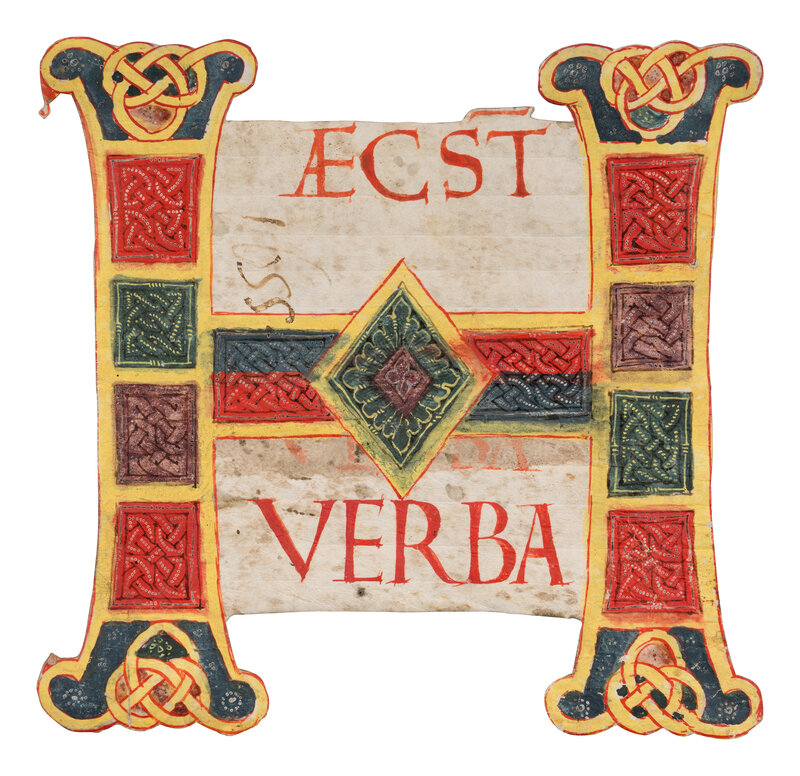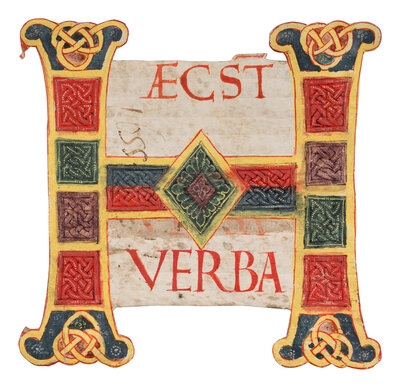Lot 1
ITALIAN ROMANESQUE ARTIST
A partial leaf from an “Atlantic” Bible, with a large illuminated initial ‘H’, in Latin, illuminated manuscript on parchment [Italy, Central Italy, Rome (?), c. 1100]
A partial leaf from an “Atlantic” Bible, with a large illuminated initial ‘H’, in Latin, illuminated manuscript on parchment [Italy, Central Italy, Rome (?), c. 1100]
Sale 2033 - Western Manuscripts and Miniatures
Jun 27, 2024
10:00AM CT
Live / Chicago
Own a similar item?
Estimate
$3,000 -
5,000
Price Realized
$3,810
Sold prices are inclusive of Buyer’s Premium
Lot Description
ITALIAN ROMANESQUE ARTIST
A partial leaf from an “Atlantic” Bible, with a large illuminated initial ‘H’, in Latin, illuminated manuscript on parchment [Italy, Central Italy, Rome (?), c. 1100]
A partial leaf from an “Atlantic” Bible, with a large illuminated initial ‘H’, in Latin, illuminated manuscript on parchment [Italy, Central Italy, Rome (?), c. 1100]
Harking back to Carolingian models, this beautifully painted and finely written example comes from a giant “Atlantic” Bible, so named to allude to something vast and expansive like the Atlantic Ocean.
140 x 145 mm. Partial leaf, ruled by knife or stylus for at least one column of 18 lines, written in brown ink in an elegant Carolingian miniscule, ONE VERY LARGE ILLUMINATED INITIAL, its staves, which at the upper and lower ends are knotted and outline the initial’s body, form various smaller segments composed of panels of green, red, purple and blue, with the latter bearing interlaced patterns heightened with white or yellow dots, the painting of the cross-stave of the initial has necessitated repositioning “verba” in the incipit -- an earlier version is only partly erased with slight smudging and ‘1655’ written vertically on the left (pasted on passe-partout, stains with transfers of ink and color in the center, some spots, else in very good condition).
This imposing cutting of an initial H came from a giant (“Atlantic”) Bible of a type produced in Italy throughout the twelfth century. The initial begins and at the same time embraces the opening of the Book of Deuteronomy it introduces, “Haec s[un]t verba…” Words directly following the initial are written in rustic display capitals. The verso comprises fragments from a later part of Deuteronomy, “Audite illos [et quod justum est] judicate sive civis sit ille sive peregrinus...”
The development of the Atlantic Bible, to reflect the status of the text and often of the donor, is likely to have been initiated in Rome in the final quarter of the eleventh century and continued in Tuscany, where production flourished. The style of this initial and the script of the verso indicate that it was painted in central Italy, very probably in Rome, probably in the first quarter of the twelfth century.
This leaf has been related to models established in Roman book production as early as the late eleventh century, for example the Bible in the Bayerische Staatsbibliothek in Munich (MS Clm. 1300), commissioned in Rome by Emperor Henry IV and given to Hirsau Abbey before 1084. Similar decorative schemes were continued in Central Italian workshops in the first decades of the twelfth century. On f. 23v in a Bible in the Biblioteca Medicea Laurenziana (MS Pluteo 15.10), we find an initial H comparable to our initial, although composed of smaller, nearly quadrangular segments. These artistic connections suggest that this initial, like its sisters formerly in the Esther Rosenbaum collection, were once part of an early Bible produced in Central Italy, maybe in Rome at the beginning of the twelfth century or slightly earlier.
Provenance
(1) The Cornelius J. Hauck Collection, Cincinnati Museum Center, Cincinnati; Christie’s, New York, 27 June 2006, lot 88.
(2) Robert McCarthy, London, MS BM 1599, acquired in 2006.
Sister leaves
Several initials formerly in the collection of Esther Rosenbaum were sold at Sotheby’s, London, 23 April 1983, lot 6.
LITERATURE
Published in: Christie’s, 27 June 2006, lot 88; Gaudenz Freuler and Georgi Parpulov, The McCarthy Collection, Vol. I, Italian and Byzantine Miniatures, London, 2018, no. 5, pp. 24-25.
We are grateful to Gaudenz Freuler for permission to quote from his catalogue in this entry. Freeman’s | Hindman thank Senior Consultant Sandra Hindman and Elliott Adam for their assistance in the preparation of this sale.
Condition Report
Contact Information

